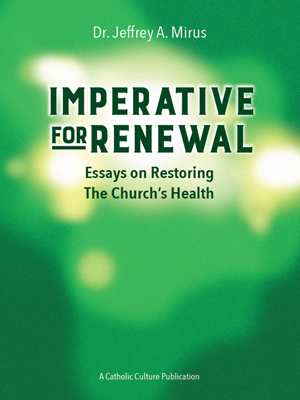The MOST Theological Collection: Vatican II: Marian Council
"Chapter 1 - Upgrading the Downgrade"
"Council votes to downgrade Mary." That is the way the headlines ran, one warm day in October, 1963, as a result of a heated day at the Council. Since that day, devotion to Mary, interest in the doctrine about her have declined sharply. More than one well-backed report is heard of priests trying to talk older people out of saying the Rosary, of nuns giving it up as out of date since Pope John.
What is the real truth about the Council action? In the interest of intellectual honesty, we ought to try to find out.
Our first clue comes from the actual records of the Council. The question had been raised: Should the Council speak of Mary in a separate document, or in the document on the Church?
The very strength of the feelings running at the Council made it advisable to find a way to avoid endless wrangling on the floor. It was agreed that each side should choose a spokesman to present its views.
First spoke Cardinal Santos, from the Philippines. He defended the use of a separate document for Mary, and in the course of his presentation, he endorsed some of the most advanced theological positions about her. For example: "She stood, suffering with Him as He died for us, meriting Redemption with Him."
Then Cardinal Koenig of Vienna arose to speak for the opposition. If anyone would favour "downgrading" it should be he, the champion of the forces opposed to the Santos group. His very first words were these: "I do not contradict the things that are presented by the other eminent Father in this matter. I contradict neither as to the doctrine nor as to the devotion that flows from it. In fact I very gladly and with my heart agree with all these things."
Cardinal Santos had defended a most advanced doctrine: that Mary shared in redeeming us. Cardinal Koenig leader of the faction which the press said favoured downgrading, not only does not contradict: he heartily accepts and concurs.
What should one think of the integrity of a press that pretends to give the facts, actually gives the opposite!
We ought to explore the real teaching of the Council on Mary. For that purpose, we will trust no commentator no supposed authority. We will work from the actual words of the Council itself. (To simplify references: All quotations from Vatican II in this chapter are taken from Chapter 8 of the Constitution on the Church, unless otherwise noted. We will, however, add, at suitable points, in the body of the text, the marginal numbers of the Council text).
To begin our survey of the teachings of the Council on Mary:
After describing her free acceptance of the role of Mother of God at the Annunciation, the Council adds (§ 56): Rightly then do the Holy Fathers [of the Church] judge that Mary was not just employed by God in a passive way but that she co-operated in human salvation by free faith and obedience. For she, as St. Irenaeus says, "being obedient, became a cause of salvation for herself and the whole human race."
Before going on to explore the remarkable implications of this statement, we might note in passing the stress the Council places on Mary's obedience, a hated word in our times. Many are saying: "If I do something because I am commanded, there is little or no spiritual value in it." The Council not only disagrees, but teaches instead the opposite. The value of Mary's consent was precisely in her obedience. In fact, in the very first chapter of the same document, the Council makes our entire Redemption depend on obedience (§ 3): "By His obedience He (Christ) brought about Redemption."
The Council, as we saw, quoted St. Irenaeus, one of the early Fathers, who was Bishop of Lyons in Southern Gaul in the second century. His words are of special interest because he himself tells us that when he was young he had often listened to St. Polycarp, Bishop of Smyrna, recount what he had heard St. John the Apostle say, during the last years when John lived at Ephesus, near Smyrna.
If we read the full passage in St. Irenaeus, from which the Council quoted, we find that he was comparing and contrasting Mary with Eve. Eve, says St. Irenaeus, had contributed to bringing down upon us the rum of sm. Mary contributed to undoing that evil. "Just as she [Eve] ... being disobedient, became a cause of death for herself and the whole human race, so Mary ... being obedient, became a cause of salvation for herself and the whole human race."
St. Irenaeus had also compared all sin, original and personal, to a tangled knot, and then added: "... for in no other way can that which is tied be untied unless the very windings of the knot are gone through in reverse ... Thus, then, the knot of the disobedience of Eve was untied through the obedience of Mary."
He means this: If one wants to undo a tangled knot, he must take the end of the cord, make it go in reverse through every twist and turn that was made m tying it. Then and only then will the knot be untied.
Mary, says St. Irenaeus, untied what Eve had tied.
Now St. Irenaeus was commenting on the scene of the Annunciation, the day of the Incarnation, which began the process of Redemption. He says that Mary cooperated m redeeming us. Did he have in mind a cooperation by Mary that went beyond that day? We do not know. His knot comparison should imply more, for the knot was not really untied at the Annunciation: Calvary was needed to complete the work. So his words should imply that she shared in the Redemption not just by being the Mother of the Redeemer, the one from whom He received the flesh without which He, a Divine Person, could not have died. The comparison could mean that she took part in the great sacrifice itself.
Really, St. Irenaeus was an instrument in the hands of Divine Providence. He himself may not have seen all that the Spirit saw, and intended to begin to convey to the Church through his words. But St. Irenaeus was far from alone: this theme of the New Eve had appeared already in the Dialogue with Trypho of St. Justin, born in Palestine not long after 100 A.D. Christ, he says "... was made man of the Virgin, so that the disobedience brought on by the serpent might be cancelled out in the same manner in which it had begun ... For Eve... brought forth disobedience and death. But Mary ... answered: 'Be it done to me according to your word.' " We note again that St. Justin puts a stress on obedience.
Out of the many Fathers who give this same doctrine, we might listen to just one more. Tertullian, writing only slightly later, about 210 A.D. said: "... God, by a rival method, restored His image ... For into Eve ... had crept the word that established death; likewise, into a Virgin was to be brought the Word of God that produced life, so that what had gone to ruin by the one sex, might be restored to salvation by the same sex."
Even if we had only these three witnesses to Catholic teaching, we would be able to be sure that the New Eve parallel, with its important implication on the Redemption, was part of divine revelation. For Tertullian mirrors the faith of the Church in Africa; Irenaeus, the Church in Asia Minor and Gaul, and Justin, the Church in Palestine. Thus between them they can reflect the fact that the entire Church believed in the New Eve, and had begun to understand that just as Eve contributed to the ruin of our race m original sin, so did Mary contribute to lifting that bane, by her obedience, joined to that of the New Adam.
Vatican II tells us the special force of something that is believed by the entire Church. In §12 of the Constitution on the Church the Council says: "The entire body of the faithful, since it has the anointing from the Holy One, cannot be deceived in its belief." In other words, what the whole Church believes is infallible, even if the authorities of the Church have not yet issued a definition of that belief.






